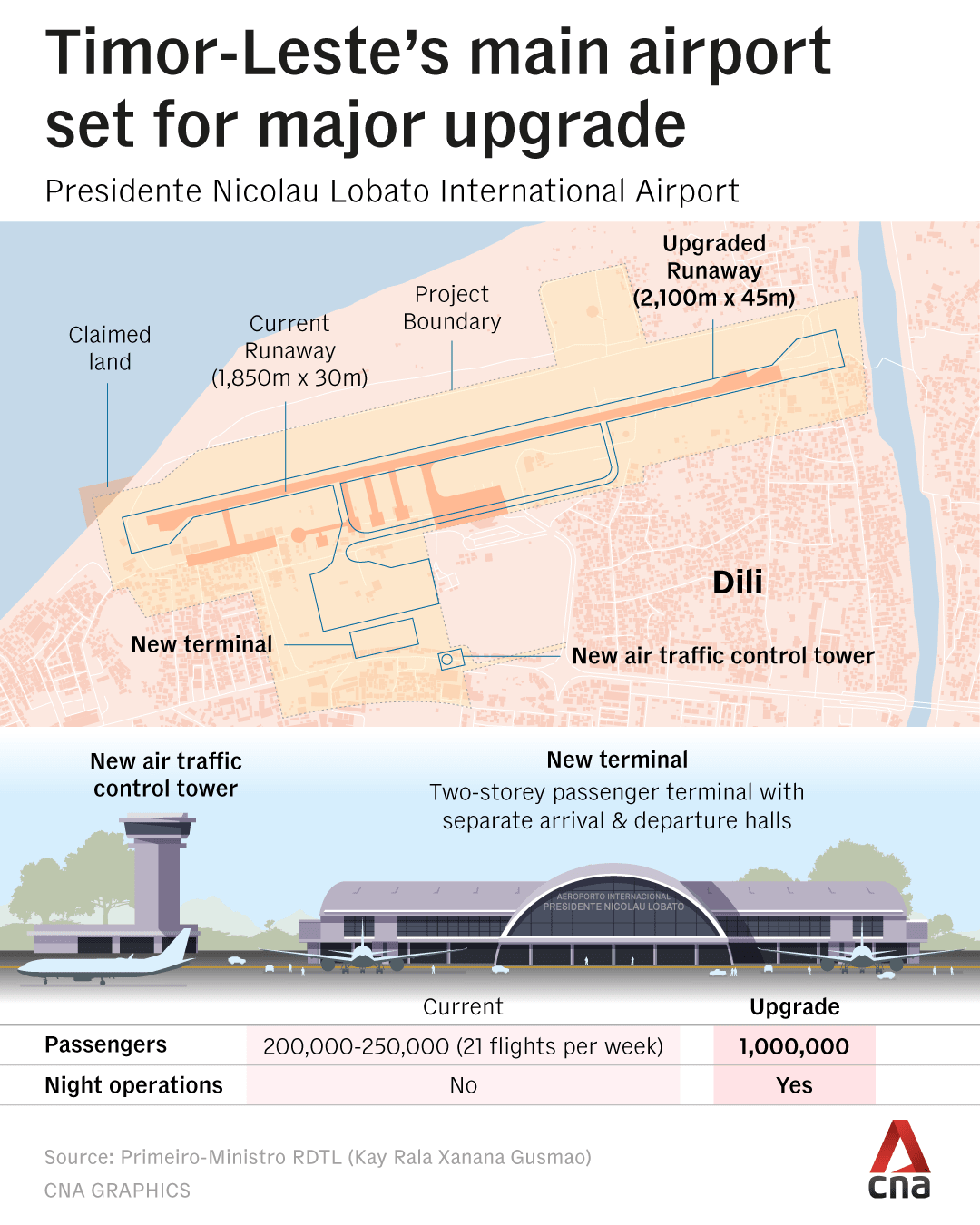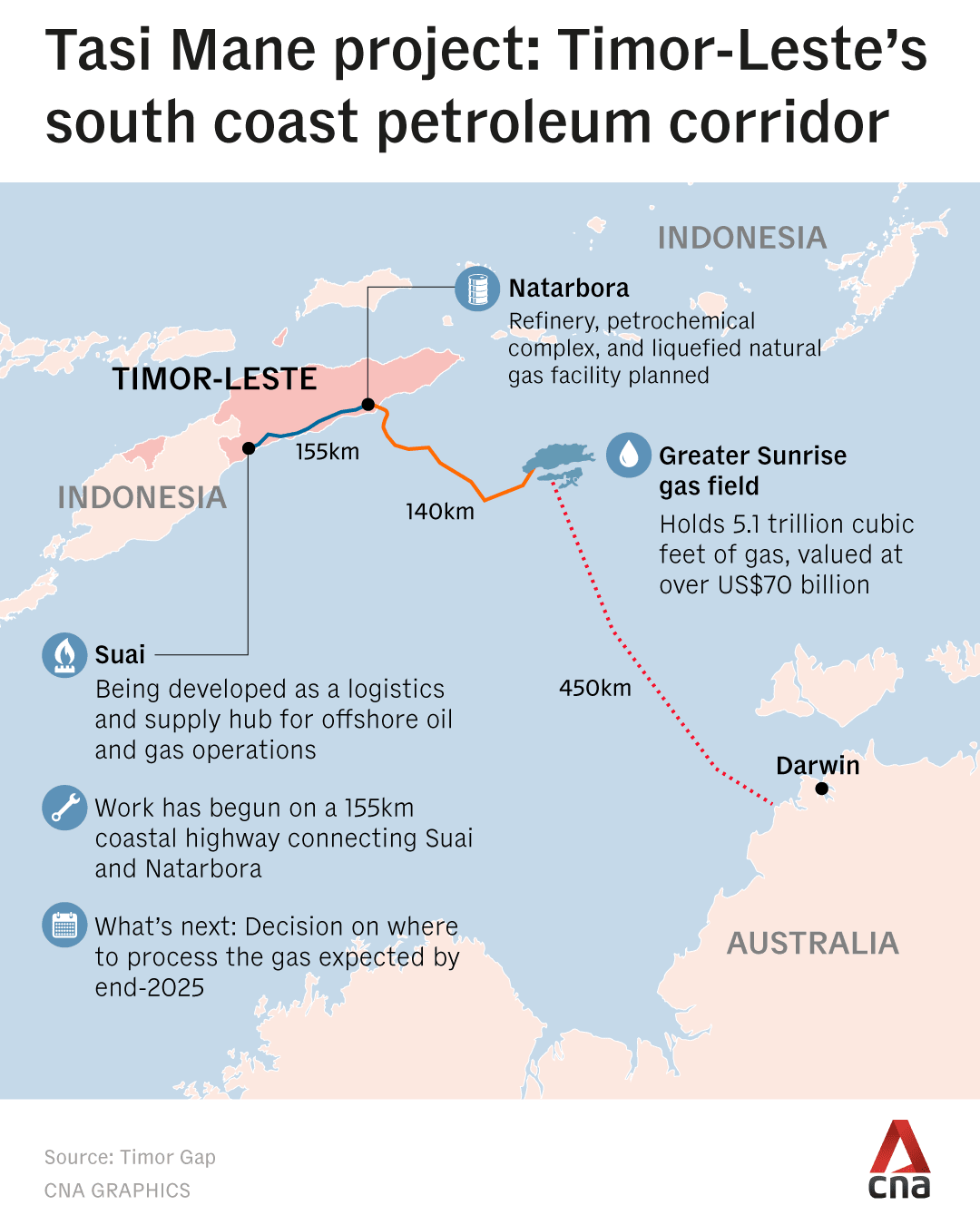Timor-Leste expands airport, eyes major gas project ahead of 2029 ASEAN summit
ASEAN’s newest member is busy laying the groundwork for future growth, but observers say policy continuity and overreliance on oil revenue could derail progress.

The buildings of the President Nicolau Lobato International Airport are seen from the runway in Dili, East Timor, on Sept 12, 2024. (Photo: AFP/Yasuyoshi Chiba)

This audio is generated by an AI tool.
DILI: Timor-Leste is accelerating efforts to improve its infrastructure, as the Association of Southeast Asian Nations’ (ASEAN) newest member gears up to host its first summit for the regional grouping in 2029, and transform its economy.
The small country of about 1.4 million people formally joined the bloc last month as its 11th member.
From modernising its international airport to an ambitious gas project off its south coast, Dili is laying the foundations for growth. But observers say challenges remain.
AIRPORT UPGRADE
A major upgrade of the Presidente Nicolau Lobato International Airport, Timor-Leste’s main international gateway, is in the works.
The improvements are aimed at accommodating larger aircraft – along with higher passenger volumes – and strengthening air connectivity.
Currently, the airport operates just 21 flights a week, serving both domestic and international routes. It handles between 200,000 and 250,000 passengers annually.
After the upgrades, that capacity is expected to rise to around 1 million passengers a year.

The airport’s limited facilities mean it can only operate during daylight hours for now – but the upgrades will allow flights to run at night.
As part of the first phase of development, its runway will be extended from 1,850m to 2,100m and widened from 30m to 45m.
A new air traffic control tower and a two-storey passenger terminal with separate arrival and departure halls will also be built.
The project, supported by both domestic funding and international donors, is scheduled to begin in January and is expected to be completed in early 2028.

HOSPITALITY AND MICE SECTOR
Hospitality is another area earmarked for development.
Dili currently has only one five-star establishment, The Palm Springs Hotel, which has 150 rooms and suites.
The hotel began operations earlier this year, and demand for premium accommodations is expected to grow - especially now that Timor-Leste has joined ASEAN.
“This is the very first five-star hotel standard that we need to achieve,” said Jackson Lay, director of JYL International Group, which operates the nine-storey hotel.
“We don't have a pool of skilled people. So, over the last eight months, we've been investing heavily in training, and we will continue to do so.”
Lay added that the cost of electricity is high in Timor-Leste, especially for commercial and industrial consumers. This is partly due to significant reliance on diesel-generated electricity, which involves high operational expenses.
"We have solar panels supplying 10 per cent of daily power, and are adding another 10 per cent. So, within this year, we will be able to achieve 20 per cent solar power to operate this hotel," he added.
Meanwhile, Pelican Paradise – a seafront resort on Timor-Leste’s northern coast – is under development, and a plan for a five-star casino hotel has been proposed.
The country is also seeking to strengthen its meetings, incentives, conferences and exhibitions (MICE) industry.
In September, the government announced plans to build a new, larger convention centre in Dili.
“(A) convention centre is a very important venue for big meetings. We don't have one right now,” said Milena Maria da Costa Rangel, the country’s vice-minister for ASEAN affairs.
“It's not only to host ASEAN meetings in the future. Of course, we will also use it for other activities as well.”
BIG BET ON GAS
On Timor-Leste’s southern coast, work has begun on a new highway – part of a petroleum corridor known as the Tasi Mane project. Stretching about 155km, the highway is designed to connect Natarbora and Suai on the coast.
At the heart of this effort lies the Greater Sunrise gas field, located in the Timor Sea about 140km off Timor-Leste’s coast and 450km northwest of Australia’s Darwin city.
The field holds an estimated 5.1 trillion cubic feet of gas, valued at more than US$70 billion.
Talks are still ongoing on where to process the gas, with a decision due by the end of this year.
Timor-Leste has said it wants the gas piped to its shores, arguing it needs the project more than Australia.
“There is no other option. If the pipeline doesn't come to Timor-Leste, the development of Greater Sunrise is not going to happen – it will stay buried and we have to look for alternatives,” President Jose Ramos-Horta told CNA.
The consortium responsible for developing the Greater Sunrise fields is made up of state-owned oil and gas firm Timor Gap, which holds 56.56 per cent, Australia’s Woodside Energy with 33.44 per cent, and Osaka Gas Australia with 10 per cent.
Last year, an independent study was completed to help authorities decide on the most viable development route for the field.
Domingos Lequi Siga Maria, vice president for the Greater Sunrise Development at Timor Gap, said the study found that sending the gas to Timor-Leste and building a liquefied natural gas plant there was both technically possible and commercially worthwhile.
Timor-Leste has already begun laying the groundwork with the coastal highway.
Natarbora, which will receive the gas, is envisioned as a hub for a refinery, petrochemical complex and liquefied natural gas facility.
Meanwhile, Suai is being developed as a logistics hub to support oil and gas exploration and production in the Timor Sea.
In Suai, the upgraded Xanana Gusmao International Airport will play a role in supporting companies operating in offshore oil and gas fields.

But progress comes with a cost.
Just east of Suai’s airport, families will soon be relocated to make way for development.
Among them is Matilda de Jesus, 70, who has lived in her house for more than four decades.
"I feel very sad because the government will expand the airport, so the government will evict us,” she said. “It has been decided, and we cannot refuse. The house provided is very small. It is not a big house.”
CHALLENGES AHEAD
Timor-Leste’s spending remains heavily supported by its Petroleum Fund, drawn from finite offshore oil and gas revenues.
Advocacy groups warn that the country must diversify its economy – and manage its wealth more carefully – to secure a sustainable future beyond oil.
“The people of Timor-Leste still feel that much of the country’s money is being wasted,” said Feliciano da Costa Araujo, executive director of the human rights group HAK Association.
“You could say that financial management remains quite difficult. So for us, it’s not just about relying on the Petroleum Fund – economic diversification will only happen if the government has both the commitment and the capacity to manage those funds properly,” he added.
Observers also warn that policy discontinuity remains a major hurdle.
“With every change of government comes a new set of policies,” said Jose Alves da Costa, executive director of Luta Hamutuk, a non-governmental organisation that monitors development in the country.
“Even if the current administration has a good plan, the next may choose not to continue it. So, a new plan is drawn up, and before it’s even implemented, another change occurs. There’s little continuity in planning, and that’s the real challenge,” he added.
Political pressure can also force abrupt policy shifts.
In September, Timor-Leste’s parliament withdrew a proposal to grant lifetime pension allowances to lawmakers following public protests.
For now, infrastructure projects like the international airport upgrades are something the Timorese look forward to over the next few years.
“Every single country, the airport represents its identity. My dream is that the Nicolau Lobato airport can represent Timorese culture," said traveller Emilio Dos Santos.


















